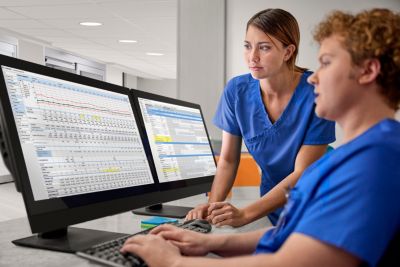
Taking the leap: 6 reasons to standardize patient monitoring across your IDN
- Featuring
- July 15 2025
- 5 min read
It’s a message Amy Martin embraces: Patient monitoring is a mission-critical system, so it’s time to treat it like one. As Head of Standards for Monitoring at Philips, Martin has seen health systems establish uniform platforms for their PACS and EMR – encouraging common workflows, timely information access and scalability – while leaving their patient monitoring fragmented. Here, she shares the risks of following the legacy model, as well as the transformative benefits of moving to a standardized monitoring solution, ideally one that connects data across the entire integrated delivery network.
At-a-glance:
- Monitoring platforms and configurations often vary across health systems – not only among care sites but even from unit to unit within the same hospital.
- Continuing with such a monitoring patchwork can burden staff, affect patient safety and influence the patient experience, while failing to address healthcare trends.
- Standardizing patient monitoring across the enterprise promotes a consistent care experience, supports frontline teams and provides health systems with needed flexibility.

Rife with challenges, patient monitoring patchworks call for a transformative, unified response
Siloed purchasing and installation have left health systems with a patchwork of monitoring platforms and configurations – not just across their care sites but often from unit to unit within the same hospital.
This ad-hoc approach can lead to monitoring gaps, missing or delayed data, integration challenges with other systems, and limited visibility into patient insights. It can also lead to confusion over alarm parameters, inconsistent workflows – with barriers to making needed changes – and burdensome manual tasks.
Variations in who gets monitored (and how) and the ways clinical teams respond potentially affect patient safety and the patient experience, Martin says. Given today’s healthcare environment – higher-acuity patients, continued consolidations and heightened expectations for quality care – the response calls for a comprehensive transformation rather than the piecemeal approach of the past.
Upgrading patient monitoring one department at a time raises the risk that health systems never reach full optimization.

Amy Martin
Head of Standards for Hospital Patient Monitoring
Philips
“Upgrading patient monitoring one department at a time raises the risk that health systems never reach full optimization,” Martin says. “Software updates cause early beneficiaries to fall behind, leaving systems stuck in a constant cycle of catchup, rather than in a position of staying ahead.”
Here Martin describes six key reasons to take the needed leap to a single, enterprise-wide monitoring solution running the same software (and on the same version):
1. Technological equity across care sites
Previously, some sites within a health system may have missed out on the monitoring upgrades others received. An enterprise-wide model, in contrast, ensures teams gain equal access to innovations such as clinical decision support tools, regardless of location or patient populations served.
This cohesive approach promotes a high standard of care across the system, Martin says, as well as a consistent experience for patients and clinicians. Teams can transfer patients to other locations knowing they will get the monitoring they need. Clinicians who float between sites can rely on the same updated monitoring solution regardless of the day’s assignment.
2. Full integration with other information systems
With fewer interfaces to manage, a single monitoring solution can promote simpler and more reliable connections with additional health information systems such as the EMR, Martin points out.
By breaking down integration barriers, a standardized platform ensures critical data flows back and forth between these systems. It cuts down on manual entries for clinicians and provides them with the timely information they need for critical decisions.
3. Support for frontline teams and their workflows
Moving patients between monitoring systems may require manually entering data, not to mention disconnecting and reconnecting equipment. (Recommendations for lead placement may even vary between platforms.) At the same time, nurses work with a wide range of technologies and devices beyond monitoring.
A standard monitoring solution – ideally one with a shared, intuitive interface across models and acuities – reduces the number of systems nurses must use and the number of screens they must consult. In addition to addressing nurses’ overall cognitive burden, a common solution can simplify training, promote intended use, and reduce equipment transitions and monitoring gaps.
Once monitoring use is streamlined and standardized, Martin says, health systems can take the next step by consulting with their teams to optimize workflows and introduce innovation.
4. Shared patient insights
By reducing monitoring gaps, standardization can help create a more complete patient picture for informed care decisions and documentation, Martin says. It may even open the door to capturing and connecting patient data from other medical devices.
When a centralized informatics platform seamlessly connects such monitoring across the enterprise, clinicians have timely access to patient insights, regardless of their location within the health system. It opens up possibilities such as taking actions on mobile devices – freeing clinicians from the bedside and central stations when not needed – and collaborating with colleagues in other locations.
5. Informed alarm management and response
The burden of alarm fatigue and desensitization and the connection to false or non-actionable alarms has been well-documented. A lack of standardized monitoring can amplify these problems, Martin says.
To start, alarm parameters often vary between care sites in the same health system and even between units in the same hospital – in part because of equipment differences. Staff may not have full awareness of parameter differences and may not recognize all alarm signals and their meanings, creating a potential safety risk.
While health systems can try to establish consistent alarm configurations and settings, doing so is difficult with disparate monitors, Martin says. And it doesn’t necessarily address unwanted alarms and alarm management – you can’t improve what you can’t measure, and you can’t really capture comparable alarms data without uniform, connected monitoring.
A standardized solution driven by an informatics platform offers an answer. It provides familiar monitor features and alarm protocols for staff. And it creates a data-driven path for safely adjusting alarms for specific types of care units, particular populations and even individual patients – a complex goal often unattainable in the past.
6. Flexibility and scalability
Ongoing healthcare consolidation and emergency department crowding show the need for a flexible approach to patient monitoring – one that accommodates both daily spikes in demand and less frequent public health emergencies.
A standardized and connected platform can overcome the limits of patchwork monitoring to provide the responsiveness required, Martin says. As needs arise, monitors on the same network can quickly get moved to where they’re needed, allowing health systems to plan for contingencies and respond.
A fully connected solution also provides flexibility for future needs. A health system might want higher-acuity monitors, for example, or wish to integrate a new hospital or partner. Shared infrastructure makes that possible, while supporting efforts to keep the whole platform stable and secure.
Copy this URLto share this story with your professional network
Sign up for news and updates

Disclaimer
Results are specific to the institution where they were obtained and may not reflect the results achievable at other institutions. Results in other cases may vary.
